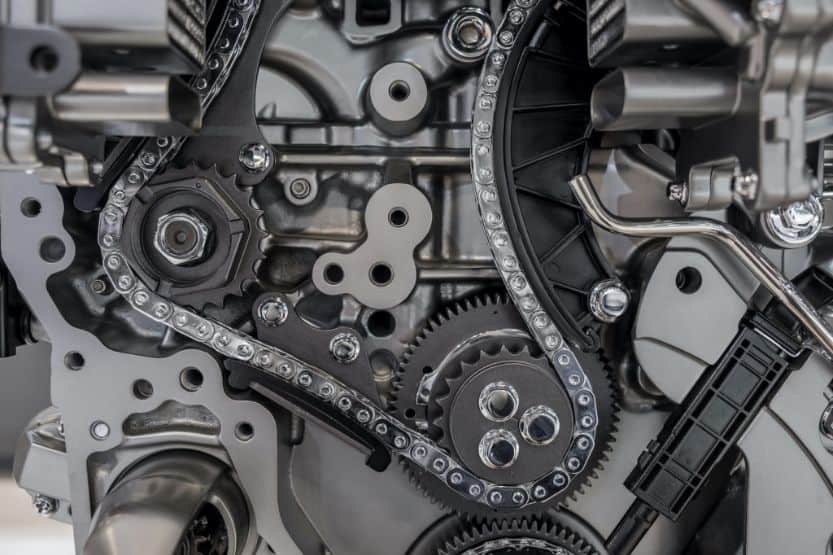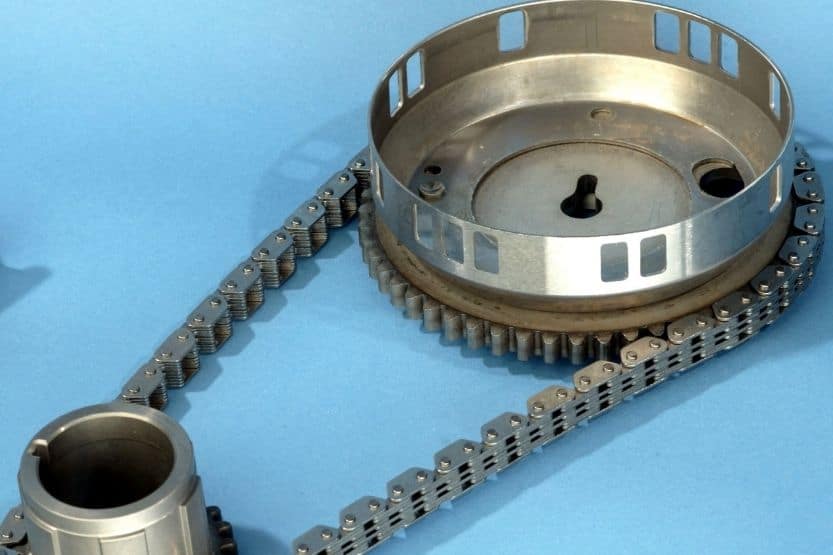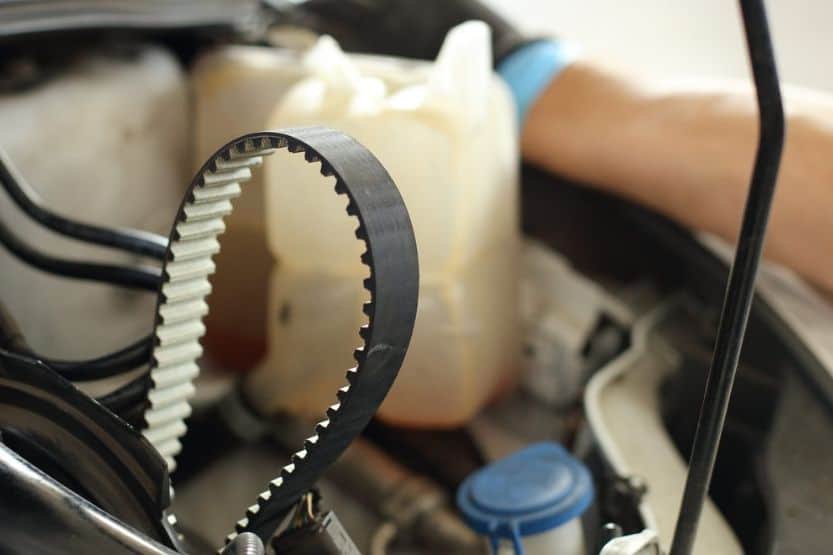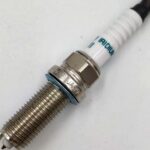The timing chain and timing belt synchronize the rotation of a vehicle’s camshaft and crankshaft. While they serve the same function, it’s helpful to know the differences between them if your car or truck has issues.
The timing chain synchronizes the movement of specific engine parts. This is similar to the timing belt. The main difference is that the timing belt can drive the water pump on some car models.
The timing chain and timing belt are different in terms of their construction, location, and noise. A timing chain has metal as its component, is louder, and is within the engine. In contrast, a timing belt is made of reinforced rubber, quieter, and outside the engine.
Read on to learn more about the differences between a timing chain vs. timing belt.
Timing Chain vs Timing Belt

The timing chain and timing belt are both used to synchronize the movement of specific engine parts. The main difference between them is that the timing belt can drive the water pump on some car models.
Most people use the terms timing chain and timing belt interchangeably, thinking they mean the same thing.
Other similarities and differences between a timing belt and timing chain are as follows:
1. Material
The main difference between a timing belt and a timing chain is the material. This is important because it directly impacts durability and performance.
Timing chains are made of metal. It is a thicker material compared to what is used in a timing belt, making it heavier and more durable.
Rubber is the main material in timing belts. However, traditional rubber easily degrades over time. It is vulnerable to damage, so it uses other materials to increase strength, such as fiberglass.
2. Location
The two are also different in terms of their position in the engine. The timing chain is located within the engine, while a timing belt is located outside the engine.
3. Durability
The material and the location are also directly related to durability. A timing chain is more durable because of its high-strength material. To add, it is located inside the engine, which means that it receives lubrication.
In contrast, a timing belt is made of rubber. It is a flexible material that is more prone to breaking compared to timing chains. Additionally, since it is outside the engine, it dries out and cracks easily.
On average, a timing belt will last 60,000 to 100,000 miles. On the other hand, a timing chain will last 150,000 to 200,000 miles, which is almost as long as the lifespan of the car itself.
4. Noise
This is one thing that we can tie to the material used. As mentioned earlier, timing chains are made of metal. They create a louder sound when they move compared to timing belts, which are made of rubber. Some drivers may find this annoying, while most will not notice the difference.
5. Price
Between the two, timing belts are cheaper to replace. While the timing chain is more expensive, the price difference is not that much.
6. Damage
Another major difference between a timing chain vs. a timing belt is the extent of the damage they inflict on the engine and your car. While problems with both can have serious repercussions, a broken timing chain has worse implications than a broken timing belt in most situations.
To learn more about a timing belt vs timing chain, see the below video:
We’ve looked at the difference between timing chains vs. timing belts: The timing chain is used to synchronize specific engine parts’ movement. This is similar to the timing belt. The main difference is that the timing belt can drive the water pump on some car models.
Next, let’s look at the specifics of the timing chain.
What Is a Timing Chain?
In the 1960s, the timing chain was the conventional option for most vehicles. It maintains the precision of the engine’s timing.
Additionally, it links the crankshaft and camshaft to the engine, making sure that they turn at the same time. It allows the engine to operate based on the amount of power used.

You will find timing chains in older car models. They are built for overhead camshafts, which you will not often find in newer models. Most of these chains can outlive cars, but it causes significant damage to the engine once they break.
How Does a Timing Chain Work?
The pistons in an engine will move up and down. The crankshaft will then produce the power that is necessary to change the rotation. After this, the crankshaft will move the camshaft through the chain. Meanwhile, the transmission is on the other end, which will move the wheels.
What Happens When a Timing Chain Breaks?
The damage depends on the specific situation. If it happens when the engine is at a low speed, the timing chain will slide off. A quick adjustment fixes this problem.
On the other hand, when it breaks at high speed, it destroys almost everything it is in contact with. Repairs are sure to be expensive!
We have earlier noted that a timing chain is made of metal. It is heavy, so once it breaks while the engine is at full speed, it can destroy other engine components. And when this happens, there are times when it is cheaper to replace the engine than repair each broken part.
When to Replace a Timing Chain?
Do I need a new timing chain?
If you are curious, the easiest way to answer this question is to pay attention to mileage. Experts recommend replacing a timing chain after 80,000 to 120,000 miles or as soon as you experience a problem that limits the engine’s performance.
In most cases, a timing chain will last as long as the engine. However, there are also instances when the chain experiences damage first, and so, it warrants an immediate replacement.
Some of the most common symptoms of a failing timing chain include loud noise from the metal, engine misfire, dismal performance, the “check engine light” is illuminating, engine vibration, and failure to start. This is similar to a timing belt or chain.
How to Change a Timing Chain?
While it is a job best handled by professionals, some people replace timing chains by themselves. Yes, it can be a DIY task, but you might think twice if you are not a handyman. You might end up making the problem worse.
If you are curious about how to replace a timing chain, here’s how to replace it:
- Look at the manual and religiously follow what the manufacturer states;
- Before you start, clean the engine by spraying a degreaser. This minimizes mess and makes it easier to remove any component you need to get rid of;
- Disconnect the battery cables. Working with the battery plugged in puts you at risk;
- Open the radiator cap and drain the coolant. Use a screwdriver to remove the drain cock;
- Locate the radiator hose, squeeze the clamp, wiggle, and remove;
- Loosen the serpentine belt, slide it off the pulley, and remove;
- Remove the heater hoses, water pump, and crankshaft pulley;
- At this point, you will already see the timing chain. Remove the cover by unbolting it from the engine block;
- Loosen the tension gear using a ratchet or wrench and pull the timing chain;
- If you are going to replace the chain, make sure to lube all components before their assembly;
- Position the chain into the gear, making sure of proper alignment;
- Tighten the chain depending on the torque specified in the manual; and
- Replace the seal of the crankshaft and reassemble the components earlier removed.
Next, in our comparison of the timing chain vs. timing belt, let’s take a closer look at the timing belt.
What Is a Timing Belt?
A timing belt works like the chain in a bicycle. Its main function is to synchronize the movement of all the internal parts. In some cars, it also powers the injection, oil, and water pumps.
This rubber belt has hard teeth, making sure that the intake and exhaust valves move along with the pistons.
As the modern equivalent of a timing chain, a timing belt is more common in newer car models. If you have recently bought a brand-new car, chances are, it has a timing belt. It has advanced features that can maximize your engine’s performance.
How Does a Timing Belt Work?

To understand the mechanisms of a timing belt, you must know the four strokes or phases in a four-stroke engine, which include the following:
- Intake Stroke: At this point, the air-fuel mixture gets into the combustion chamber. The piston goes down, and the intake valve opens, allowing the fuel to penetrate the cylinder;
- Compression Stroke: This is the time when the air-fuel mixture is compressed. This happens after the piston moves up while the valves stay closed;
- Combustion Strike: This is a rapid and oxidizing chemical reaction that results in the piston’s moving down and delivering the power that a valve needs; and
- Exhaust Stroke: The exhaust valve will open, which will allow the excess air and fuel to leave the engine.
While the four phases above are happening, the timing belt is also functioning. It turns both the camshaft and crankshaft pulley.
If the timing belt is not working, then the two parts will be out of sync, resulting in a serious problem. The valve timing will be off, and it can damage different parts of the engine.
What Happens When a Timing Belt Breaks?
The timing belt often breaks when you start or stop an engine. When the tension on the belt is at its highest, putting a strain on the rubber.
When the timing belt breaks, the crankshaft and camshaft will no longer have synchronized movements. While the pistons still rise, the valve cylinder will no longer open.
Aside from the valve, the cylinder wall, pistons, and cam heads are also damaged. Repairing the engine will cost anywhere from $3,000 to $4,000.
If you have a non-interference engine, a timing belt is easy to replace. In contrast, when you have an interference engine, the damage is more severe. You will have broken valves and cylinders. In some instances, you might even need to replace the entire engine.
When to Replace a Timing Belt
Do I need a new timing belt?
There’s no easy way to answer this question. Among others, mileage is one of the most important indicators. If your car has anywhere from 60,000 to 100,000 miles, you will need a new timing belt.
The most common signs that you need a timing belt replacement include engine misfire, engine vibration, overheating, leaking oil, problem starting the engine, “check engine” light is lit, and unusual noise. Most of these signs are similar to the symptoms of a failing timing chain.
So when it comes to replacing a timing belt or timing chain, both produce similar signs. Usually, the noise you hear or unusual engine vibration will be a tell-tale sign of an issue for both.
How to Change a Timing Belt?
The replacement of a timing belt is a complicated task that is best reserved for the pros. However, if you want to know how to do it, take note of the steps listed below:
- Disconnect the negative terminal of the car’s battery;
- Depending on the model of the vehicle, it is necessary to remove the alternator or serpentine belt. Undo the nuts, push the alternator, and pull the belt;
- Access to the timing belt covers requires the removal of the other accessories, including the air conditioning compressor and steering pump;
- Using a socket or wrench, align the timing marks. After this, remove the harmonic balancer pulley then pull the cover of the timing belt;
- Remove the screws that hold the timing belt cover;
- Loosen the bolts that secure the belt tensioner. Obliterate it if you will be replacing the belt;
- Check the pulley, making sure that there are no damages, such as cracks. Otherwise, you will need to replace the pulley as well;
- After removing the timing belt, it’s time to install a new one. Slide the new belt on the sprocket;
- Tighten the belt depending on the torque the manufacturer recommends; and
- Return all the parts you have earlier removed.
Conclusion – Timing Belt vs Timing Chain
The timing belt or chain are both used to synchronize the movement of specific engine parts. The main difference between the two is that the timing belt can drive the water pump on some car models.
Your car will either have a timing chain or timing belt, which is a component responsible for synchronizing the crankshaft and camshaft rotation. They make sure that the valve opens and closes when the cylinders fire, which is crucial for a vehicle’s performance.
As noted in this quick timing chain vs. timing belt comparison, the two have notable differences. A timing chain is made of metal and is stronger. However, it is quite louder. On the other hand, a timing belt is made of rubber, making it more vulnerable but quieter.
Both the timing belt and timing chain can result in significant damage. In most cases, however, the damage caused by the timing chain is worse, to the point that you might need to replace the entire engine.
Related reading:


![Bad Timing Belt Symptoms [6 Main Symptoms] Bad Timing Belt Symptoms](https://roadsumo.com/wp-content/uploads/2021/09/bad-timing-belt-symptoms-150x150.jpg)
![Moped Vs Scooter [What Are the Differences Between Them?] moped vs scooter](https://roadsumo.com/wp-content/uploads/2021/06/moped-vs-scooter-150x150.jpg)



![Read more about the article Neo Chrome – Wrap, Paint, Wheels [Full Guide]](https://roadsumo.com/wp-content/uploads/2022/05/neo-chrome-300x200.jpg)

